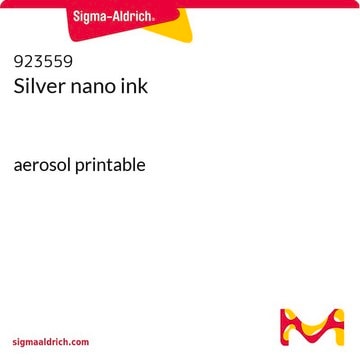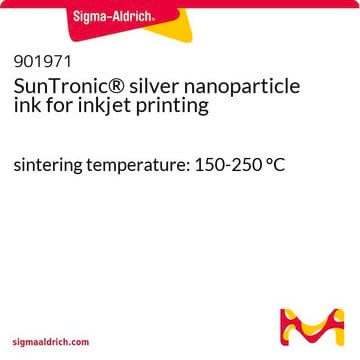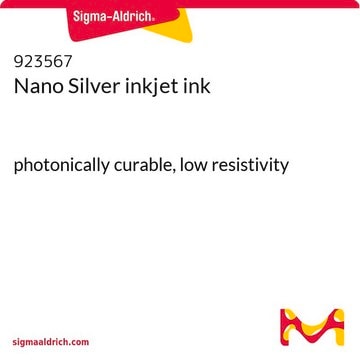The detailed preparation method for the silver nanoparticles in this product is considered proprietary and cannot be disclosed. Generally, commercial methods for creating a stable dispersion include using surfactants, stabilizers, or dispersing agents. Additionally, techniques such as sonication and high-shear mixing can be effective for achieving stable dispersions. These methods can also be applied when preparing a paste of copper nanoparticles in a similar solution.
907669
Silver ink
75 wt%, LIFT printable
Sinónimos:
Ag ink, Laser induced forward transfer
Seleccione un Tamaño
Seleccione un Tamaño
About This Item
Productos recomendados
descripción
Silver content : 75 wt%
Solvent : Diethylene Glycol Mono Butyl Ether (DGBE)
Surface Tension : 28 dyn/cm (Pendant Drop)
Formulario
paste
tamaño de partícula
50-70 nm (by Lumisizer™)
90-120 nm (by Lumisizer™)
viscosidad
50,000-100,000 cP (Shear Rate: 1 s-1
250cP - 450 cP (Shear Rate: 1000 s-1))
densidad
2.85-3.3
temp. de almacenamiento
15-25°C
Categorías relacionadas
Aplicación
The ink offers:
- Uniform and reproducible donor layer with low drying speed
- Stable accurate jetting in different types of laser systems, wide working window of jetting parameters
- High speed printing (20-50kHz), allowing high throughput
- Narrow patterning on plastic and glass substrates (line width ∼50 μm, height ∼0.5 μm, spacing ∼50 μm)
- Laser sintering of LIFT printed pattern, providing good electrical properties
Fit for:
LIFT digital printing
Additive electronic manufacturing
Printed electronics: RFID, FPD, Sensors
Laser induced forward transfer printing (LIFT) is a non-contact, nozzle-free, one step, direct laser writing process.[1][2]
LIFT can operate under atmospheric conditions, is compatible with low laser fluences, allows the printing of organic and inorganic materials as well as biological elements. The printing process can take place from both liquid and solid phases. It further has a high lateral resolution only defined by the laser spot size. It is a method compatible with inorganic semiconductor sensor fabrication, OLED fabrication and bio printing[3].
Otras notas
*Parameters should be optimized depending on line geometry and substrate
Almacenamiento y estabilidad
Información legal
Palabra de señalización
Warning
Frases de peligro
Consejos de prudencia
Clasificaciones de peligro
Aquatic Acute 1 - Aquatic Chronic 1 - Eye Irrit. 2
Código de clase de almacenamiento
10 - Combustible liquids
Clase de riesgo para el agua (WGK)
WGK 3
Punto de inflamabilidad (°F)
Not applicable
Punto de inflamabilidad (°C)
Not applicable
Elija entre una de las versiones más recientes:
Certificados de análisis (COA)
¿No ve la versión correcta?
Si necesita una versión concreta, puede buscar un certificado específico por el número de lote.
¿Ya tiene este producto?
Encuentre la documentación para los productos que ha comprado recientemente en la Biblioteca de documentos.
Los clientes también vieron
Artículos
Small molecular weight organic semiconductors are promising for flexible transistor applications in next-gen soft electronics.
Professors Tokito and Takeda share design principles and optimization protocols for organic electronic devices, focusing on flexibility and low cost.
-
Hello, could you please disclose how the silver nanoparticles were dispersed in the solution? I am trying to make a paste of copper nanoparticles in a similar solution and would like to know a commercial method for stable dispersion. Thank you
1 answer-
Helpful?
-
Active Filters
Nuestro equipo de científicos tiene experiencia en todas las áreas de investigación: Ciencias de la vida, Ciencia de los materiales, Síntesis química, Cromatografía, Analítica y muchas otras.
Póngase en contacto con el Servicio técnico










